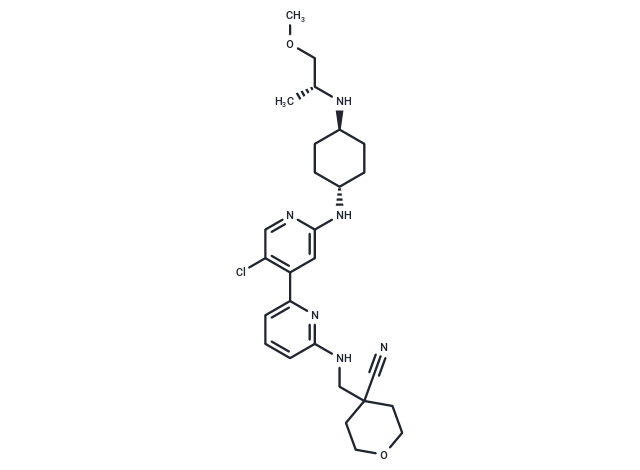Shopping Cart
- Remove All
 Your shopping cart is currently empty
Your shopping cart is currently empty

NVP-2 is an effective and selective ATP-competitive cyclin-dependent kinase 9 (CDK9) probe. NVP-2 induces cell apoptosis. NVP-2 inhibits CDK9/CycT activity (IC50: 0.514 nM). NVP-2 shows inhibitory effcts on CDK1/CycB, CDK2/CycA and CDK16/CycY kinases (IC50: 0.584 μM, 0.706 μM, and 0.605 μM, respectively).

| Pack Size | Price | Availability | Quantity |
|---|---|---|---|
| 1 mg | $50 | In Stock | |
| 2 mg | $72 | In Stock | |
| 5 mg | $122 | In Stock | |
| 10 mg | $213 | In Stock | |
| 25 mg | $463 | In Stock | |
| 50 mg | $683 | In Stock | |
| 100 mg | $973 | In Stock | |
| 1 mL x 10 mM (in DMSO) | $137 | In Stock |
| Description | NVP-2 is an effective and selective ATP-competitive cyclin-dependent kinase 9 (CDK9) probe. NVP-2 induces cell apoptosis. NVP-2 inhibits CDK9/CycT activity (IC50: 0.514 nM). NVP-2 shows inhibitory effcts on CDK1/CycB, CDK2/CycA and CDK16/CycY kinases (IC5 |
| Targets&IC50 | CDK9:0.5 nM (IC50) |
| In vitro | NVP-2 exhibits anti-proliferative activity against leukemia cells, specifically targeting KOPT-K1, Jurkat, P12-ICHIKAWA, DU.528, MOLT 16, HSB-2, PF-382, SKW-3, SUP-T11, DND-41, and HPB-ALL cells with IC50 values of 0.1688 μM, 0.1233 μM, 0.5736 μM, 0.1575 μM, 0.1620 μM, 0.1585 μM, 0.1808 μM, 0.2589 μM, 0.0918 μM, and 0.3023 μM, respectively. NVP-2 (0-10 nM; 72 hours) demonstrates CRBN-dependent anti-proliferative and pro-apoptotic effects in MOLT4 cells (IC50: 9 nM). At 250 nM for 24 hours, NVP-2 induces apoptosis in MOLT4 cells, increasing caspase-3 and γH2A.X expression, although this effect is significantly reduced upon compound washout. Additionally, NVP-2 (250 nM-1 μM; 6 hours) engages CDK9 in both wildtype and CRBN - / - MOLT4 cells without affecting CDK2 and CDK7. |
| Molecular Weight | 513.07 |
| Formula | C27H37ClN6O2 |
| Cas No. | 1263373-43-8 |
| Smiles | COC[C@@H](C)N[C@H]1CC[C@@H](CC1)Nc1cc(c(Cl)cn1)-c1cccc(NCC2(CCOCC2)C#N)n1 |
| Relative Density. | 1.23 g/cm3 (Predicted) |
| Storage | Powder: -20°C for 3 years | In solvent: -80°C for 1 year | Shipping with blue ice. | |||||||||||||||||||||||||||||||||||
| Solubility Information | DMSO: 100 mg/mL (194.91 mM), Sonication is recommended. | |||||||||||||||||||||||||||||||||||
Solution Preparation Table | ||||||||||||||||||||||||||||||||||||
DMSO
| ||||||||||||||||||||||||||||||||||||

Copyright © 2015-2025 TargetMol Chemicals Inc. All Rights Reserved.